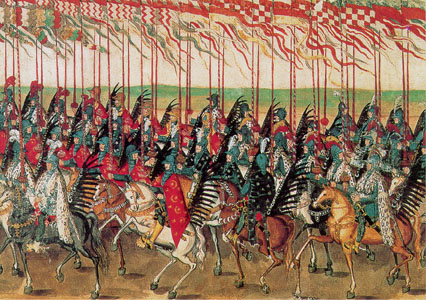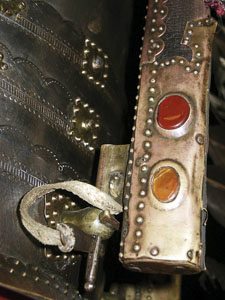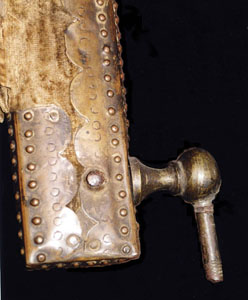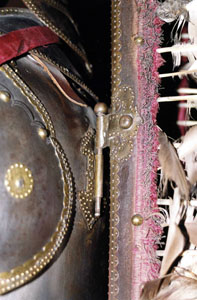This was my entry into the Aquaterra
All-Champions competition. This paper really focuses on one of my
biggest interests, and something that, in the end, I would like to be
known for; the Hussar Wings. Though I did not win this championship,
I'm proud of my work, and the information that I have gathered so
far.
Starszyzna
Futro Wilka i Husarskie Skrzydła
(Veterans
Wolf Skin and Hussar Wings)

"Hetman's Guard" by Wacław Pawliszak
Aquaterra All Champions 2014
Entry
by HL Jadwiga Radomyskowa
Overview:
For most people the
middle ages is the purview of Western Europe, those whose gaze go
beyond familiarity might think of the Middle East or Russia. It is
rare that one's historical eye goes to Central Europe, but when it
does, one figure stands out above all the rest. The Polish winged
hussar. The image is unmistakeable, an armored knight on horseback,
leopard fur thrown across his shoulders, lance at the ready, and two
huge wings arcing over his head.
For those of in the
Society of Creative Anachronism it should come to no surprise that
the image commonly held by paintings and media doesn’t quite square
up with the reality. I am here today to present my entry for the
Aquaterra A&S Championship which covers two of the most iconic
images of the Hussar; the wings and the fur over the shoulder.

The
Classic Image of the Hussar
The
Hussars.
The first recordings
of the Hussars being used in Poland is in 1503 when three units of
Hungarian Hussars were brought in by the Polish sejem (parliament),
they were a transitional cavalry force, while much of the rest of the
world was moving away from armored knights, in Poland things were, as
usual, a little different. The Hussar originally was a lightly
armored fighter, with a huge variety of weapons available to him, the
most common being the lance, saber, ax, box and pistols. To say that
these warriors were ready for just about any occasion was an
understatement!
By the 16th
Century, the Hussars were pretty much Poland’s only military force.
Infantry was pulled from allies, or mercenaries. By the late
sixteenth century they had become the heavy cavalry that is so often
depicted modernly. By the time Stefan Batory became king of Poland
in 1576 he had codified the Hussars into a royal guard and for the
first time, had requirements for what armor and weapons a hussar must
have.
Where there are gaps
in our knowledge, it is common for historians to fill in the details,
sometimes even deliberately making false claims to further the glory
of this unique Polish military unit. We cannot just trust period
drawings, and paintings as hussars were so culturally impressive they
they were often shown adorned with wings regardless of occasion, time
of year, or time in history!

Polish
Husaria by Józef Brandt
The
Persona
My entry focus on
the persona of Mikołaj Radomyski. At this time it is 1569 near the
Polish town of Radom. Mikołaj runs a small village to the east,
where he oversees farmers, a few merchants and craftsmen. His father,
Andrzej is part of King Sigismund II Augustus' foreign delegation,
where he helps visiting ambassadors and other dignitaries. He is
married to Jadwiga of Krakow, (Jadwiga Radomyskowa), a daughter to
lesser nobles who work on the bloodlines of the Kings horses.
As with most men of
fighting age, Mikołaj is part of his Majesties army, and has spent
time battling against the Ottoman empire, the Rus and helping quell
troubles in Pomerania. Currently he is in Lublin taking part in what
will be known as the union of Lubin, which will combine Poland and
Lithuania into one of the greatest areas at the time. This momentous
occasion is why Mikołaj has arrived in all of his finery.
Submission
the First: Starszyzna Futro Wilka (Veteran's Wolf Skin)
The Poles were known
for their outrageous looks. It was often said that whatever Western
Europe was doing you could bet that Poland was doing the opposite.
During the 16th century there arose the Sarmation
movement, wherein it was “discovered” that the Polish people were
descended from the great Sarmation warriors of history. Now there is
little to no evidence to suggest that there is an unbroken line of
warriors from ancient Sarmatia to medieval Poland, but that little
detail did not stop the Polish people from making it their cultural
identity
To that end, there
are many stylistic resemblances to middle eastern, and oriental dress
and armor. The chief of which at this time was the wearing of
predators skins around one's shoulder. It is interesting to note,
that while most contemporary paintings of Hussars show them wearing
leopard and tiger skins, it was only those of lesser rank who wore
them. Veterans, officers and those of rank would wear the skins of
wolves, bears and lynx, never leopard or tiger.
16th
century engraving of a Polish Hussar
This may seem odd,
considering that the feline skins are far more exotic and rare. Why
would you put them on your lower ranked soldier? The answer is two
fold. First, leopard and tiger skins would rarely be bought for this
purpose, rather they would have been looted from Tarter soldiers
defeated in battle. In many ways, these skin, though rare, would be
seen as a lesser quality than the others, as they are war bounty from
a defeated foe. Secondly, wolves, bear and lynx are known creatures
to the Poles whereas tigers and leopards are only ever seen dead and
skinned. The soldiers knew of the true ferocity of these animals, and
had likely hunted them as well, whereas they only had rumors of how
ferocious these “gaudy painted cats” were. Moreover, to wear the
skin of a native animal marked a soldier as one with the Motherland.
He displayed his might by carrying the ferocious creatures of his own
forests.
There is a third,
and amusing reason for this strange reversals of rank and
skin-wearing. Often the Poles at this time found themselves fighting
against the Turks who were well known for capturing important
opponents alive and ransoming them back. In more than one occasion it
is said that the Turks would go after the leopard clad soldiers
unknowingly ignoring their high ranking superiors Thus capturing a
man of less importance, and leaving a commander alive.
To make these skins,
the animal would be hunted or trapped by men who's sole job was to
take down predators for their fur. This was done with bow or spear,
accompanied by hounds bred to harry and stand up to these creatures.
Upon slaying the animal, it would be tanned by scraping the flesh and
fat from the skin, and then the leather would be cured and softened
by applying dog and bird dung or by treating it with a solution of
barley, rye and stale beer. Once the hide was cured, it was backed
and lined with felt or silk, which was glued on, and then stitched at
the edges. Finally it would have attachments placed on it, either
brass clasps, or ropes to tie it over the shoulders.

The
Stockholm Roll – Most famous painting of the Hussars
Submission
the Second: Husarskie Skrzydła (Hussar Wings)
It could be easily
argued that the most iconic item of a Hussar was his wings. And while
they are well known, there is a lot of contradicting information
about them. I present to you the results of my research and my
conclusions based on that information.
Hussar's originally
painted the image of a white eagles wing on their curved shields.
This is in reference to the white eagle that Poland uses as her
symbol Over time, the wings became actual bird wings nailed to the
shields, and then wings attached to the soldiers shoulders, and
finally on the back of the soldier as we see today.
The wings I am
presenting today are the last of these, and what would have likely
been seen in the 16th century. These wings were made by
cutting out a length of wood that was bent and shaped to the simple
curve at the end. It would be painted, and adorned with red felt or
silk, much brass-work, even gems at times. From there, holes were
drilled on it's outer edge, and feathers were attached with resin.
Holes and gapes were filled in with down, smaller feathers or plant
fibers.
That the wings
existed there is no question. There use however, is hotly debated.
There are three main
ideas concerning the use of hussar wings:
- To protect the Hussar from lassos swing by the Tartars
- When charging, the wind whistling through the feathers would make a hissing noise to scare the enemy
- To prevent the enemy from guessing the true size of a hussar charge.
- A symbolic decoration likening the hussars to Angels or as parade gear.
Ironically, in my
research and based on period writings only one of these bears out to
reality.
- Lasso prevention: While the Tartars did use lassos, they did not use them against heavy armored fighters. Even assuming the Hussar didn't have the wing, you still have a heavily armored fighter, in a saddle specifically designed to keep him in place during battle. It would be foolish to even try.
- Noise: This ideas is probably the most popular that I've heard over the years and the one that is least likely to bear any truth. The construction of the wings, even when attached to the hussars back does not make much noise. Moreover, when speaking to a knight, Earl Edward Ian Anderson he mentioned that while big and terrifying, they are quite quiet. Moreover in the midst of a battle, where men and horses are dying, pistols and cannons are being fired and two armies are clashing, you are not going to hear the quiet sounds made by feathers over that cacophony
- Size of the army: This is another unusual theory However existing records for many army’s all say pretty much the same thing, only shoot when you actually have a target. It was too expensive to waste bullets. However the wings did have a psychological effect They were strange, and unless you had fought the hussars before and lived to tell about it, you would never had seen anything like this before.
- This is the only use that actually has good amounts of reliable evidence supporting it. There are many period writings of gear that a hussar needs for battle and for parade, and only in parade are the wings and feathers required. Also, during this time, the hussars were all but undefeated on the battlefield, and both their allies and foes liken them to angels.
 Hussars at the Battle of Kircholm in 1605 painted in 1630. Note that the hussars do not wear wings.
Hussars at the Battle of Kircholm in 1605 painted in 1630. Note that the hussars do not wear wings.
Cardinal Enrico
Gaetaniego on June 22 1596 wrote “[sic] over their backs, attached
to the saddle protruded powerful wings of huge bird feathers done.”
White this doesn’t tell us much about the construction of the
wings, it clearly marks them as being attached to the saddle.
There are a few
examples of hussar armor with wing attachments on the back, but these
are few and far between, most being later century forgeries. It
appears that the only time wings were attached to the back was for
paintings, or when a Hussar needed to be in his finery and for some
reason, not mounted.
Wings only really
could be used for parade decoration. Two wings attached to the back
or saddle would not allow for fighting correctly. The placement of
the upright poles does not allow a soldier to swing a sword. Only
strike with a lance, and shoot his pistol. As the Hussars were so
elite it is unlikely they would willingly handicap themselves during
battle. Also, there are no written records of the wings being used in
battle, only paintings showing this.

16th
Century woodcut of a hussar
Creation
Wolf fur drape
When it came to make
this piece of finery I settled on the wolf, rather than the lynx, the
bear or a leopard. I did not use a lynx because Mikołaj isn't a
small guy and the hide of the feline would look too small on him. He
would be able to wear a bear quite nicely, however bear hides do not
come cheap and it was not feasible to acquire one at the time. While
a leopard might have better represented Mikołaj as a squire, I
wanted something that would look good for years, and the faux fur on
the market did not cut it for me. So the wolf it was.
I squired the wolf,
and carefully cut him so that he would drape correctly on Mikołaj 's
shoulders. Then I treated the skin with rabbit skin glue and applied
the deep red felt to it, which I then cut with piking shears to
create a nice edge. I then added the ties to the wolves muzzle and
paw. This is still a work in progress, and I will eventually be
adding a second tier of felt that will be hand stitched to the hide.
Hussar Wings
I was gifted the
base for Mikołaj 's wings by Earl Edward Ian Anderson who cut them
out of pine and painted them. From there, I gathered the other items
I would need. As Mikołaj does not have a back-plate, or a horse, I
created a plate for him so that he could wear the wings. I covered
the back plate with felt, and added brass accents to it, including
his device.
I then found modern
attachments that best mimicked the medieval fittings. These were peg
and post made of brass that are locked in place by a pin.



17-19th
century reproductions of hussar wing attachments.
Then came the
tedium, I marked and drilled out all the holes for the feathers, and
then arranged the feathers by size so they would look wonderful, and
curve correctly. I chose to use turkey feathers because their banded
appearance would mimic young eagle wings, and they were legal to
acquire I then did the brass-work for the wings, and set in many
brass tacks to add a little nicer decoration to the slats. After
that, I glued the feathers in place with hot glue. I used this
method, in case a feather broke, so that I could heat the area, melt
the glue, and pull out the broken feather returning an unbroken one
in it's place. Finally I added two red ties to the wings, so that
they would be stabilized on Mikołaj 's back.
The
Finished Result
Sources
Brzezinski, Richard, and Velimir Vuksic.
Polish Winged Hussar, 1576-1775. Oxford: Osprey, 2006. Print.
Radzilowski, John. A
Traveler’s History of Poland, second edition. Interlink
Books, 2013. Print
Zamoyski, Adam. Poland: A History.
New York: Hippocrene, 2012. Print.
Lemnis, Maria, and Henryk Vitry. Old
Polish Traditions. Interpress Publishers, 2000. Web. 19 June
2014.
Zamoyski, Adam. The Polish Way: A
Thousand-year History of the Poles and Their Culture. New York:
Hippocrene, 1994. Print.
Brzezinski, Richard, and Angus McBride.
Polish Armies 1569-1696 (2). London: Osprey, 1988. Print.
Brzezinski, Richard, and Angus McBride.
Polish Armies 1569-1696. Oxford: Osprey, 2004. Print.
Jadaszewski, Eryk Stefan. Polish
Re-enactors Handbook: A Guide to 17th Century Living History in the
Polish-Lithuanian Commonwealth. Lexington, KY: S.n., 2008. Print.
Jadaszewski, Eryk Stefan. Polish
Re-enactors Handbook: A Guide to 17th Century Living History in the
Polish-Lithuanian Commonwealth. Lexington, KY: S.n., 2008. Print.
Głębowicz, Witold. "Legenda
Skrzydlatych Husarzy - Historia, Fakty I Mity - Inne Oblicza
Historii." Inne Oblicza Historii News. Other Faces of
History, 2011. Web.

No comments:
Post a Comment